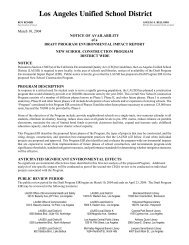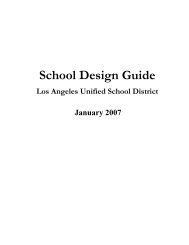Site-Specific Health and Safety Plan (HASP) - Laschools.org
Site-Specific Health and Safety Plan (HASP) - Laschools.org
Site-Specific Health and Safety Plan (HASP) - Laschools.org
Create successful ePaper yourself
Turn your PDF publications into a flip-book with our unique Google optimized e-Paper software.
LAUSD Proposed South Region High School #9 & Middle School #4<br />
6-8<br />
December 2006<br />
<strong>Site</strong> <strong>Specific</strong> <strong>Health</strong> & <strong>Safety</strong> <strong>Plan</strong> (<strong>HASP</strong>)<br />
6.3.2.1 Support Vehicles<br />
Contractor/subcontractor personnel shall wear seat belts <strong>and</strong> obey posted speed limits on<br />
roadways within site area. Personnel shall comply with applicable state <strong>and</strong> local traffic<br />
regulations. Current or anticipated road conditions will be addressed at the daily safety briefings.<br />
No personnel shall ride in the bed of pickup trucks or st<strong>and</strong> on the side or ride on the fenders of<br />
support vehicles. Cell phones may not be used by a driver while a vehicle is in motion. Avoid<br />
other distractions as well.<br />
Personnel will conduct a “walk-around” inspection of the vehicle before moving it to ensure they<br />
do not drive over personnel or equipment.<br />
No personally-owned vehicles (POVs) will be driven into site exclusion zones, nor will<br />
contaminated equipment, personnel or material be transported in POVs. POVs must be left in<br />
support zones on site. Stunt driving, racing, <strong>and</strong> horseplay are prohibited <strong>and</strong> will be subject to<br />
disciplinary action.<br />
6.3.2.2 Heavy, Stationary or Moving Equipment<br />
Working with large motor vehicles could be a major hazard at the site. Injuries can result from<br />
equipment dislodging <strong>and</strong> striking personnel, <strong>and</strong> impacts from flying objects or overturning of<br />
vehicles. Vehicles <strong>and</strong> heavy equipment design <strong>and</strong> operation will be in accordance with CCR,<br />
Title 8, Sections 1590-1599. In particular, the following precautions will be used to help prevent<br />
injuries <strong>and</strong> accidents:<br />
• Before any subsurface work is initiated, verify that underground <strong>and</strong> above-ground utility<br />
clearances have been obtained.<br />
• Do not back up large motor vehicles unless the vehicle has backup warning lights <strong>and</strong> a<br />
reverse signal alarm audible above the surrounding noise level, or an observer signals it is<br />
safe to do so.<br />
• Motor vehicle cabs will be kept free of all nonessential items <strong>and</strong> all loose items will be<br />
secured.<br />
• All personnel working at <strong>and</strong> around heavy moving equipment must be informed of the<br />
locations of the kill switches.<br />
• When heavy equipment is left unattended, loads must be lowered, controls neutralized,<br />
power shut off, <strong>and</strong> brakes set.<br />
• Only qualified operators will be allowed to operate heavy equipment.<br />
When working near a drill rig, personnel shall be aware of snag hazards from rotating tools <strong>and</strong><br />
pinch <strong>and</strong> crush hazards from suspended tools. No loose, dangling clothing will be allowed.<br />
Personnel will be aware of slip, trip <strong>and</strong> fall hazards from drilling equipment, tools, <strong>and</strong> well<br />
construction materials that may be lying on the ground in the vicinity of the drill rig.<br />
In addition to operator vehicle safety, traffic control hazards exist when working with moving<br />
vehicles, trucks, <strong>and</strong> heavy equipment. Project personnel will be aware of his or her<br />
surroundings at all times. Pedestrians should maintain a minimum clearance distance of ten feet<br />
or greater whenever possibile, since the operator’s attention is focused on the point of operation<br />
<strong>and</strong> significant blind spots are common. Eye contact with the operators of any vehicle or<br />
equipment must be made prior to walking near moving/operating vehicles or equipment to alert<br />
199







